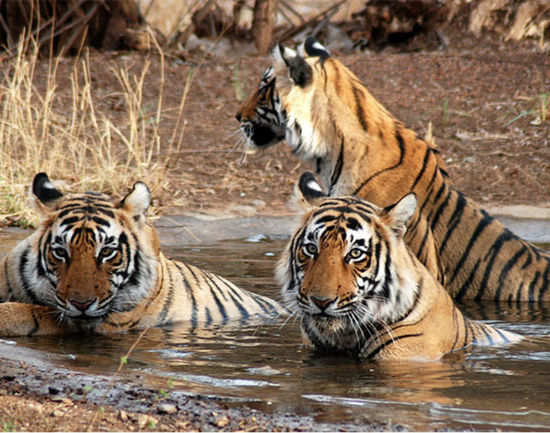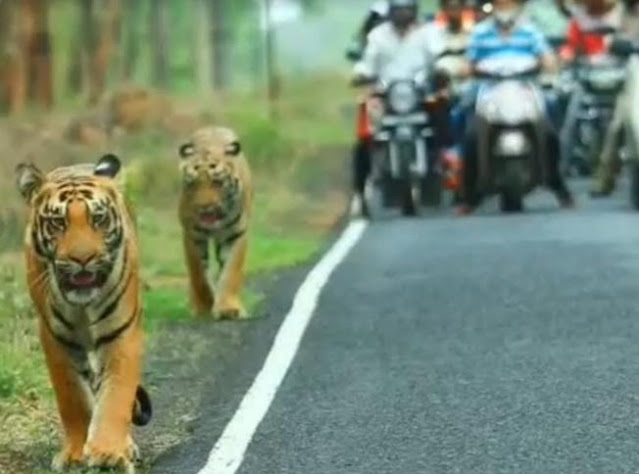Seven years ago, a tiger sitting atop a building in a busy Bhopal locality attracted the attention of the whole country. To be precise on December 25, 2015, the tiger was found sitting on the rooftop of the Central Institute of Agriculture Engineering (CIAE) in Nabi Baugh of Bhopal. Horde of onlookers assembled on the surrounding buildings and many climbed nearby trees to have a glimpse of the tiger. Wary of the large number of people , the tiger jumped onto a shed and the roof caved in making it difficult for the forest department to carry out the rescue operation to capture the tiger. The operation took a few hours to complete when the big cat was tranquilized and shifted to Van Vihar national park in Bhopal around 3 pm.
60 Tigers Ready To Move From Ratapani
The presence of the tiger over a building left the forest department clueless. Perhaps for the first time, the department realized that there were a number of tigers roaming around Bhopal - less than 10 kms away from the busy New Market -and may prove dangerous to the residents. The department also started an exercise to resolve the issue. Though the tiger sightings were already taking place on the city outskirts in Kerwa forest patch , Nabi Baugh is located in the opposite direction to Kerwa. Soon, this mystery was also resolved as the department realized that the tigers dispersing from Ratapani Wildlife Sanctuary about 50 kms away from Bhopal, were moving in both the directions – towards Raisen straying to Nabi Baugh and also towards Kerwa.
Also read: Bhopal Tigers Do Have the Same Fundamental Right to A home As Do We
Over a period of time, gradually, the source population in Ratapani sanctuary has swollen to about 60 in 2022, more than many national park of the state. After the December 2015 incident, there was a knee jerk reaction from the forest department and “they intended to shift all the tigers from Bhopal outskirts”. The then Principal Chief Conservator of Forests Narendra Kumar had told the media that ,”It’s a hilly area and we will have to use elephants to track and tranquilise the tigers.” The big cats from the outskirts of Bhopal will be shifted to other tiger reserves.” But a final decision could not be taken as the officials realized it would not solve the problem and more tigers would soon replace those captured from Kerwa”.
Rehabilitate Urban Tigers
In fact, the political masters have still not been able to take a decision, a decision to rehabilitate Ratapani tigers in the sanctuary itself. The government has been sitting over the Ratapani file for the past 9 years forcing the “unique population of tigers” to stray . Ratapani has been a wildlife sanctuary since 1976. In 2008, the National Tiger Conservation Authority (NTCA) granted an in-principle approval for upgrading it to the status of tiger reserve.
Also read:Corbett Controversy: Misplaced Priorities of Politicians
It will become a tiger reserve by the notification of the government of Madhya Pradesh. But for 14 years, the tigers of this wild life sanctuary have been waiting for their abode to be upgraded but justice continues to elude them. The government is expected to show a political will to issue a notification and accord status of tiger reserve to Ratapani.As their number increases in Ratapani, the big cats are pushed to the state capital -as if seeking justice from Bhopal babudom. But as they reach Bhopal they have been termed as urban tigers, almost on the lines of urban naxals.
Create Jungle Corridors
All the tigers moving around Bhopal are identified with the help of their pictures taken from camera trap. Geomapping of the tiger territory has also been done with the help of Google map. Their movement is monitored on a day to day basis to track change in their territory. While managing the tigers around the state capital, a new concept of urban tiger management has been coined and Bhopal tigers have become urban tigers. The tigers close to the city live in the mixed forest spread across almost 200 sq kms area in Mendora -Mendori , Veerpura villages of Bhopal forest division, Kathotia Sewaniya of Sehore and Dahod of Obedullaganj forest divisions. There are about 12 tigers moving around Bhopal . Of them about 5 have become Bhopali tigers , unique to Kerwa region as they are born and brought up there only.
Also read: Avni's killing: Core Issue of Tiger Corridors Lost in Oblivion
The undulating terrain comprises a river, 2 dams and also 23 gaushalas (cow sheds) around the forest area under electronic surveillance system .There are 4 towers each of them 50 meter high fitted with high resolution night - vision devices and cameras monitoring the movement of urban tigers. All the statistics related to the tiger are collected every day and analysed to understand the territory and spots where the predator hunts. This also helps in giving compensation to the villagers for their cattle loss. There are 23 gaushalas (cow sheds) around the jungle and the cattle from these cow shelters left in open for grazing in the jungle attract tigers.
Unique Tiger Population in Ratapani Sanctuary
Tiger population of Ratapani is unique. Their biological details do not match either to the tigers of Kanha national park nor those in Pench tiger reserve. This has also been proved in the laboratory of the National Centre for Biological Science, sources said. There is no movement of tigers from Satpuda tiger reserve to Ratapani wildlife Sanctuary. We need to develop further and maintain the forest corridor for the dispersing tigers of Ratapani. From Ratapani, the tigers move out towards Kheoni sanctuary in Dewas and while doing so they pass Bhopal.
Also read: Tiger's Epic Walk Raises Serious Environmental Issues
But they could not move beyond Laadkuee and Ichawar villages in Sehore where forest corridor is fragmented. If this corridor is developed, the tigers may move upto Omkareshwer, yet to be made a national ark sanctuary. Omkareshwer is spread in Khandwa and Dewas. Though the state government had committed to make Omkareshwer a national park, the issue has been pending since 1988. This national park along with two wildlife sanctuaries was promised by the government in lieu of the forest submerged in Indira Sagar project. There is another corridor where Ratapani tigers may move out to Nauradehi via Singhori wildlife sanctuary. “It is less than 100 km of forest corridor but fragmented and needs to be developed to let the tigers move out safely”.
Chain Link May Change Tiger Behaviour
Instead of making Ratapani a tiger reserve and Omkareshwer a national park, the government took a short cut. It decided to place a chain-link to check the movement of urban tigers while they disperse from Ratapani . Over 20 km long chain link has restricted the movement of the big cat to protect some educational institutions and residential areas cropped up in the jungle. The tigers were sighted in the campus of various institutions in Kerwa region . They also visited some of the city parks. Despite the presence of so many tigers and so much human presence, there was no known man -animal conflict reported so far. But these chain links may prove dangerous as it has created hurdles in the years of tiger movement. It is observed that the urban tiger is not comfortable as it is confined within its own house as for years; the tiger had learnt to survive without confrontation.







These are civilised tigers. Save them and their habitat.
ReplyDelete